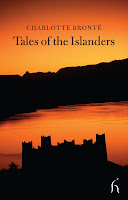Review: Tales of the Islanders, by Charlotte Brontë
 |
| Tales of the Islanders, 2011 (Hesperus Press) |
In her introduction to this volume of Charlotte Bronte’s juvenilia, Jessica Cox explains that, while composing the Brontë biography, author Elizabeth Gaskell dismissed the juvenilia as insignificant, wild writing. But as with any writer, the germs are there, the inspirations are there, and should not be ignored.
Patricia Rozema, in her somewhat controversial film adaptation of Jane Austen’s Mansfield Park emboldened the character of Fanny by giving her a writer’s mind – by giving her authorship of Jane Austen’s own material. And it’s almost seamless, believable, because it also came from Jane’s hand. Similarly, you can almost see Brontë’s romanticizing of the Duke of Wellington and others in the youthful wiles of Jane Eyre’s childhood escapism, and in the folly of Rochester’s past.
The island is described as “more like the region of enchantment or a beautiful fiction than sober reality. In some parts made terribly sublime by mighty rocks, rushing streams and roaring cataracts with here and there an oak either scathed by lightning or withered by time and, as if to remind the lonely passenger of what it once was, a green young scion twisting round its old grey trunk.” Readers may, as Cox points out, identify the “tree scathed by lightning” as the seed of the old chestnut, cleft in two by lightning in Jane Eyre.
As with Austen, though Tales of the Islanders, et al. were written when Charlotte was only 13, there is a sophisticated vocabulary at work – almost as if she were taking all of the “adult” words she knew from a list, and incorporating them into her writing (i.e. in the quote above, how many 13-year-olds know what a cataract is? Or a scion for that matter?) She listened to her father read the paper, she and her siblings read voraciously – they had a large and expansive vocabulary, which they put to good use. At that age, Charlotte was playing with adjectives, almost using as many as possible in a passage, to make an image very clear to the reader. She was still painting with heavy, broad strokes, rather than practicing the art of darkness by omission.
Her Gothicism is fresh and evident in the dark romance of a kidnapping, the mystery of figures who appear and disappear, and mischief in general seems prevalent. This, as well as the four previously published volumes written by Charlotte and published by Hesperus Classics, are neither dismissible, nor insignificant, and are worth a read for any Brontë lover, but especially for those who, like Jane Eyre, sought childhood escapism in the far-off places that books so often, and so willingly, provide.
 |
| The Green Dwarf, 2003 (Hesperus Press) |
 |
| The Spell, 2005 (Hesperus Press) |
 |
| The Foundling, 2004 (Hesperus Press) |
 |
| The Secret, 2006 (Hesperus Press) |

Comments
Post a Comment
Any and all feedback is welcome - thanks for taking the time!